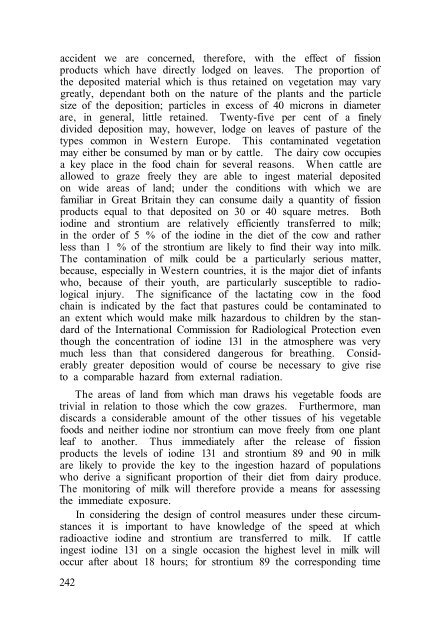septième réunion technique seventh technical meeting ... - IUCN
septième réunion technique seventh technical meeting ... - IUCN
septième réunion technique seventh technical meeting ... - IUCN
- No tags were found...
Create successful ePaper yourself
Turn your PDF publications into a flip-book with our unique Google optimized e-Paper software.
accident we are concerned, therefore, with the effect of fission<br />
products which have directly lodged on leaves. The proportion of<br />
the deposited material which is thus retained on vegetation may vary<br />
greatly, dependant both on the nature of the plants and the particle<br />
size of the deposition; particles in excess of 40 microns in diameter<br />
are, in general, little retained. Twenty-five per cent of a finely<br />
divided deposition may, however, lodge on leaves of pasture of the<br />
types common in Western Europe. This contaminated vegetation<br />
may either be consumed by man or by cattle. The dairy cow occupies<br />
a key place in the food chain for several reasons. When cattle are<br />
allowed to graze freely they are able to ingest material deposited<br />
on wide areas of land; under the conditions with which we are<br />
familiar in Great Britain they can consume daily a quantity of fission<br />
products equal to that deposited on 30 or 40 square metres. Both<br />
iodine and strontium are relatively efficiently transferred to milk;<br />
in the order of 5 % of the iodine in the diet of the cow and rather<br />
less than 1 % of the strontium are likely to find their way into milk.<br />
The contamination of milk could be a particularly serious matter,<br />
because, especially in Western countries, it is the major diet of infants<br />
who, because of their youth, are particularly susceptible to radiological<br />
injury. The significance of the lactating cow in the food<br />
chain is indicated by the fact that pastures could be contaminated to<br />
an extent which would make milk hazardous to children by the standard<br />
of the International Commission for Radiological Protection even<br />
though the concentration of iodine 131 in the atmosphere was very<br />
much less than that considered dangerous for breathing. Considerably<br />
greater deposition would of course be necessary to give rise<br />
to a comparable hazard from external radiation.<br />
The areas of land from which man draws his vegetable foods are<br />
trivial in relation to those which the cow grazes. Furthermore, man<br />
discards a considerable amount of the other tissues of his vegetable<br />
foods and neither iodine nor strontium can move freely from one plant<br />
leaf to another. Thus immediately after the release of fission<br />
products the levels of iodine 131 and strontium 89 and 90 in milk<br />
are likely to provide the key to the ingestion hazard of populations<br />
who derive a significant proportion of their diet from dairy produce.<br />
The monitoring of milk will therefore provide a means for assessing<br />
the immediate exposure.<br />
In considering the design of control measures under these circumstances<br />
it is important to have knowledge of the speed at which<br />
radioactive iodine and strontium are transferred to milk. If cattle<br />
ingest iodine 131 on a single occasion the highest level in milk will<br />
occur after about 18 hours; for strontium 89 the corresponding time<br />
242
















